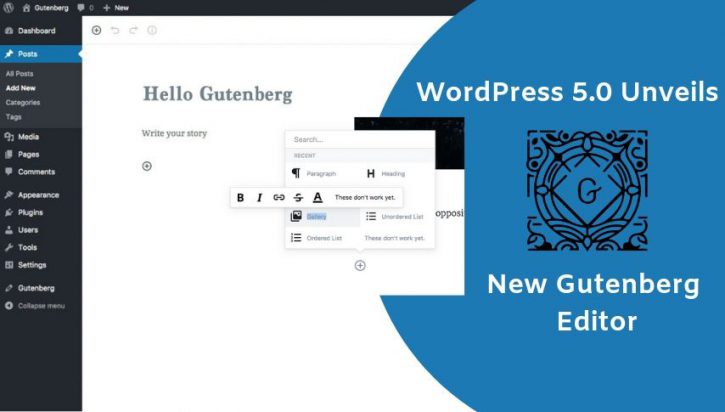
WordPress 5.0 Unveils the New Gutenberg Editor
WordPress has introduced the new Gutenberg Editor in its latest release (version 5.0) on December 6th, 2018. It has been developed as a replacement of the current TinyMCE editor and has drawn both hype and criticism during its beta stage.
What is Gutenberg?
Named after Johannes Gutenberg, the new editor for WordPress was first introduced in 2017 by Matt Mullenweg at WordCamp Europe.
This powerful editor is specifically developed for non-technical users. Gutenberg can simplify formatting blog posts with rich media and brings in “blocks” – a drag and drop like mechanism, to provide flexibility.
Gutenberg is built using React, WordPress REST API, and JavaScript and is compatible with other WordPress functionalities. Despite some initials issues, it’s the goal is to make content creation and formatting more intuitive and straightforward.
Gutenberg features
Gutenberg performs based on a block system. You can separately manipulate and style each feature within a single block. There are several alterations and changes in Gutenberg compared to the previously used TinyMCE editor. These changes have resulted in both praise and criticism.
Let’s take a look at the pros and cons:
PROS
1. Create dynamic, rich layouts
- The Gutenberg editors provide increased screen space which proves to be less distracting for developers.
- Toggle the initial letter of the paragraph between small and large with a simple “Drop Cap” button.
- The information button lets you have access to an overview of your page or post. You can access information about the number of words, headings, paragraphs and blocks along with a list of Title and Headings.
- If the toolbar along the block is distracting you, then you can move it to the top by changing the setting.
- Saving every second count. Keeping this in mind, Gutenberg developers have come up with a vast amount of shortcuts. But keep in mind that there are still some bugs regarding these shortcuts.
2. Separately shape each and every block
- Unlike the previously existing toolbar which was present above the white writing space; in Gutenberg, everything revolves around blocks. After placing the block, you will get access to a toolbar for editing the block both above and on the right side of the screen.
- Both the background and text colour can be set separately for this block.
- You can easily add or remove blocks anywhere you want. You can also move a block from one place to another by arrow buttons or dragging and dropping it in another position.
- Additional CSS Class can be added to each block to modify the style.
3. Important plugin features are built-in the editor
- In the former editor for copying the content, you had to install plugins like “WordPress Copy Content”. But now with Gutenberg, this can be done with a simple click on the “Copy all Content” button.
- One of the key features that you get in Gutenberg editor is table creation. You can change the style from regular to stripes just through a click. In the previous editor, you needed to install plugins like TablePress to create your table.
4. Better visual and media-rich content
- Create the perfect visual representation by adding images and videos along with cover images with headings and upload multiple photos with the help of the gallery block.
- From Youtube, Facebook, Instagram, Twitter, SoundCloud to Spotify there are multiple embeds available through which you can easily link to various contents.
- You can easily integrate Google Map locations.
5. Reusable blocks: a grand new feature
Reusable blocks are an awesome feature where you can make and name any block you might need to use multiple times, then by just choosing that block from a list, you’ll be able to copy the whole thing in another place.
6. Better mobile responsiveness
One of the perks of using the Gutenberg editor is its mobile responsiveness. Compared to the previous editor, you can make edits and changes more quickly and easily. It’s easier to use on small screens.
7. Widgets and Shortcode block
Different widgets are available within the Gutenberg editor for WordPress. You can import these widgets as blocks within your website.
Now that you know the benefits, it’s time that to know some of the issues the users face with the Gutenberg editor.
CONS
1. Backward compatibility issues: Conflict with themes and plugins
Backward compatibility is one of the main concerns when you update to the Gutenberg editor. You might have used different themes and plugins which required integration with TinyMCE.
These plugins may not work with the new editor. Actually, Gutenberg has compatibility issues with many popular plugins. For example, Meta box still does not work perfectly with the Gutenberg editor.
2. Column blocks are not responsive
The Column blocks in Gutenberg are not responsive. Custom coding is required to make them mobile friendly.
3. Gutenberg is trying to be a website builder
Many users complained that Gutenberg is too complex and WordPress has developed it to compete with website builders like Wix. People often prefer a simpler text editor.
Conclusion
Gutenberg is coming to you along with WordPress 5.0 whether you like it or not, and you will have to adapt to it. We all hope that there will be bug fixes in the upcoming updates. Many of you may still prefer going with the previous editor, if you are in that group, download and install the Classic Editor plugin to set things back as they were.
You read a lot. We like that
Want to take your online business to the next level? Get the tips and insights that matter.

